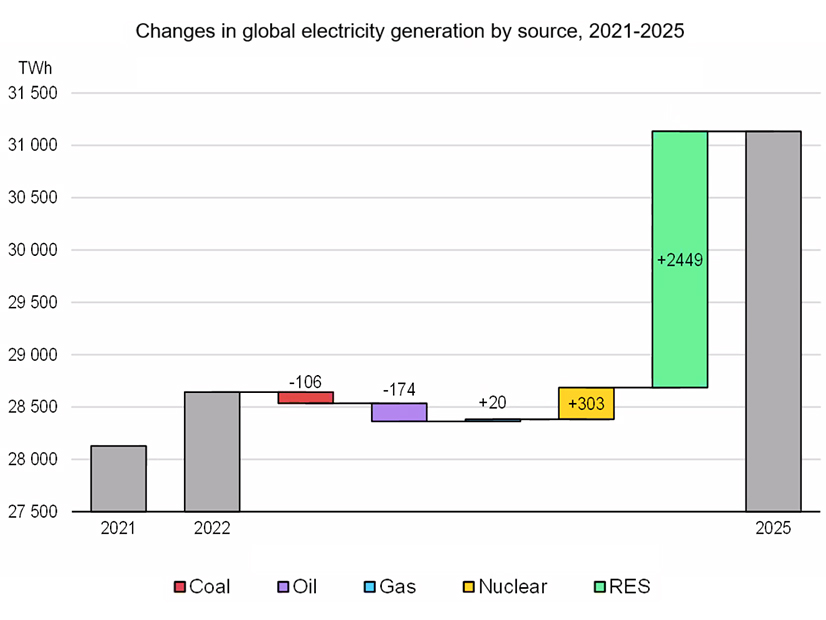Ninety percent of new generation built to meet global electricity demand over the next three years will be renewables and nuclear, according to a new report from the International Energy Agency released Wednesday.
While worldwide energy demand grew only about 2% in 2022, Keisuke Sadamori, director of energy markets and security at IEA, predicted a more robust 3% growth rate in demand per year through 2025. Emerging economies’ demand for power will be a key driver, as will advanced economies’ push for electrification to decarbonize their transportation, industrial and food sectors, Sadamori said during a media briefing on the report Tuesday.
To meet that demand, renewables will add 2,449 TWh of power to global grids by 2025, with nuclear playing a more modest role with an additional 303 TWh, and fossil fuels edging down.
“Renewables will make up over one-third of the global generation mix by 2025,” the report says. “This trend is supported by government pledges to increase spending on renewables as part of economic recovery plans, such as the Inflation Reduction Act in the United States.”
“And we should note that the substantial growth in renewables will need to be accompanied by accelerated investments in grids and flexibility, such as energy storage systems, for their successful integration into the power system,” Sadamori said.
While the U.S. market is not a primary focus of the report, the global trends discussed correspond to the current opportunities and challenges of the electric power sector here.
For example, the report’s view on the U.S. industry is mixed, predicting only modest gains in demand in the next few years. While the U.S. surpassed prepandemic levels of electricity demand in 2022, IEA sees a 0.6% drop this year “due to an expected slowdown in economic activity, before returning to an annual growth of about 1.2% in 2024 and 2025.”
However, renewables will continue healthy growth, with wind energy up 19% over 2022 levels by 2025, and solar up 56%, supported by clean energy spending in the IRA.
The U.S. Energy Information Administration recently released its predictions for new electric power generation in 2023, with renewables, storage and nuclear providing about 86% of the expected growth in supply. Solar leads with more than half of the new generation, a total of 29.1 GW.
IEA also tracks a major shift in power demand, from the U.S. and Europe to Asia. Between 2015 and 2025, China will grow from using 25% of the world’s electricity to 33%.
US has Lowest Power Price Increases
But the growth of renewables may not necessarily result in the broad reductions in carbon emissions needed to meet the Paris Agreement’s target of a worldwide net-zero economy by 2050.
Carbon emissions climbed to record highs in 2022, pushing the world well off a path to net zero, Sadamori said.
Worldwide, the electric power sector produces about 40% of global CO2 emissions, he said. The 2022 increase was largely from increased fossil-fueled generation in Europe, with Russia’s invasion of Ukraine pushing up power prices, especially in the unregulated markets of some European countries. Despite record inflation, the U.S. saw the lowest level of wholesale power price increases among advanced economies, the report says.
Sadamori believes the increase in CO2 emissions is temporary and will come down as the U.S. and Europe ramp up programs for deploying renewables and nuclear. But the decrease in emissions in the West could be offset by ongoing fossil fuel generation in Asia.
Africa presents a particularly sensitive challenge. The continent represents about 20% of the world’s population but only 3% of its electric power generation. Whether it can build out a primarily renewable electric power system remains uncertain.
IEA also sees ongoing complexities in the interaction between increased renewables on the grid and the increased frequency and severity of extreme weather events, which can drive sudden spikes in demand while also exposing system vulnerabilities.
“Mitigating the impacts of climate change requires faster decarbonization and accelerated deployment of clean energy technologies,” the report says. “At the same time, as the clean energy transition gathers pace, the impact of weather events on electricity demand will intensify due to the increased electrification of heating, while the share of weather-dependent renewables continue to grow in the generation mix.”
Energy Efficiency First
“In such a world, increasing the flexibility of the power systems while ensuring security of supply and resilience will be crucial,” the report says. Diversity of supply will be needed to ensure security, Sadamori added.
Accelerating a clean energy transition should focus first on energy efficiency with substantial government support “because the energy efficiency will lead to smaller amounts of new energy requirements,” Sadamori said. “So, that means the renewables and nuclear can provide more of the growth of the entire electricity demand.”
The report also points to vulnerabilities in the U.S. grid, such as the widespread power outages during the December winter storm. Maintaining and making “wise use” of dispatchable fossil fuel resources, in particular for emergencies, should not lead to increased carbon emissions, Sadamori said.
He also said that IEA sees carbon capture and sequestration as a long-term solution for emissions reductions, but not in the next three years. The technology is “kind of a work in progress,” Sadamori said. “It is being developed, but I don’t think they can make a substantial dent in CO2 emissions in the coming years.”



